The Reemergence of the Devil
For many Catholics, the Devil and hell have faded from sight. The only time we ever hear of Satan is when he is referred to during baptismal vows, Gospel readings of his encounters with Jesus, or during old reruns of The Exorcist or The Omen on TV.
So U.S. Catholic commentators and ordinary folk were surprised a few months ago when Pope Benedict referred to the Devil as instigating the media exposure of priestly sexual abuse.
He said the “new radiance of the priesthood,” which he saw emerging from the Year for Priests, would not be pleasing to the “enemy” who “would have preferred to see it disappear, so that God would ultimately be driven out of the world. And so it happened that, in this very year of joy for the priesthood, the sins of priests came to light–particularly the abuse of the little ones…”
“All evil is due to the intervention of the Devil, including pedophilia,” confirmed Fr. Gabriele Amorth, 85, an exorcist in the Diocese of Rome. Fr. Amorth is the author of An Exorcist Tells His Story and An Exorcist: More Stories. A third book, Memorie Di Un Esorcista was published this year. 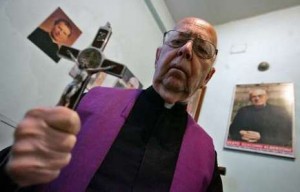
The sex abuse crisis engulfing Pope Benedict XVI and the Vatican, he said, was the work of Satan who had even “infiltrated the Vatican corridors.” Fr. Amorth emphatically stated: “Legions of demons have lodged there.” “The majority of those in the Vatican do good work, but Pope Paul VI talked about the ‘smoke of Satan’ infiltrating the Vatican as long ago as 1972.”
He claimed another example of satanic behavior was the Vatican “cover-up” over the deaths in 1998 of Alois Estermann, the commander of the Swiss Guard, his wife and Corporal Cedric Tornay, a Swiss Guard, who were all found shot dead. “They covered up everything immediately,” he said. “Here one sees the rot.” (Read my post on the murders here.)
Fr. Amorth asserted that “Lust, success and power are the three great passions on which the Devil insists.”
The exorcist has claimed in his books and interviews that Vatican clergy are involved in Satanic sects. “There are priests, monsignors and also cardinals!” The exorcist claims he got his information from “those who have been able to relate it to me because they had a way of knowing directly. And it’s something ‘confessed’ most times by the very demon under obedience during the exorcisms.”
Father Jose Antonio Fortea Cucurull, another well-known demonologist and exorcist, said that Fr. Armoth had “gone beyond the evidence” in claiming that Satan had infiltrated the Vatican corridors. “Cardinals might be better or worse, but all have upright intentions and seek the glory of God,” he said. Some Vatican officials were more pious than others, “but from there to affirm that some cardinals are members of Satanic sects is an unacceptable distance.”
Sex, power, politics and the Devil have been around the Catholic Church for centuries. Two examples that quickly come to mind are the case of Cardinal Richelieu and Fr. Urbain Grandier as described in The Devils of Loudun; and the burning of (Saint) Joan of Arc with the connivance of Bishop Pierre Cauchon.
More recently, the Devil at work in the Church was raised by a pope. In his homily given on the Feast of Saints Peter and Paul on June 29, 1972, Pope Paul VI made a famous remark that “from some fissure the smoke of Satan has entered the house of God.” 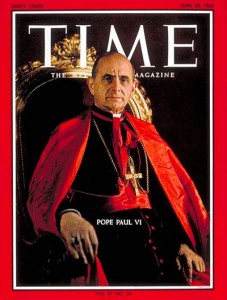
The full text of the homily was not reproduced in the Vatican collection of Paul VI’s teachings (Insegnamenti di Paulo VI Vol. X, 1972). Instead, what’s included is a narrative summary of the homily, with occasional direct quotations attributed to him.
Since we don’t have the pope’s words in context, but someone’s retelling of them, it makes it unclear exactly what the pope meant, adding a layer of ambiguity and mystery. But what was Pope Paul VI intending to warn us about when he said “the smoke of Satan has entered the house of God”?
There are a lot of theories.
-A number of ultra traditionalists believed the Second Vatican Council and liturgical reforms that followed it were the work of the Devil.
– The blogger, Jimmy Atkin, in a very interesting and well written post, posits that Pope Paul VI was responding to the cultural crisis of the 1960s and 70s and its impact on the Church. Read it here.
– Virgilio Cardinal Noe, 86, Master of Liturgical Ceremonies during the Pontificates of Paul VI, John Paul I and John Paul II, disclosed in an interview with Petrus, his inside information on the comment. 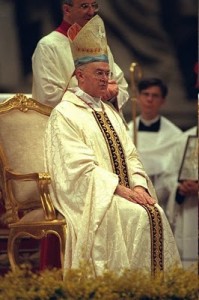
“You from Petrus, have gotten a real scoop here, because I am in a position to reveal, for the first time, what Paul VI desired to denounce with that statement. Here it is: Papa Montini, for Satan, meant to include all those priests or bishops and cardinals who didn’t render worship to the Lord by celebrating badly (mal celebrando) Holy Mass because of an errant interpretation of the implementation of the Second Vatican Council. He spoke of the smoke of Satan because he maintained that those priests who turned Holy Mass into dry straw in the name of creativity, in reality were possessed of the vainglory and the pride of the Evil One. So, the smoke of Satan was nothing other than the mentality which wanted to distort the traditional and liturgical canons of the Eucharistic ceremony.”
Now we know the Pope hated guitar Masses, too…
Cardinal Noe had the reputation for being a big fussy and exacting stickler for ceremony. This may have influenced how he interpreted a private or public comment from Paul VI combined with his own distaste for modern Masses.
-The most delicious theory is that there are actual Satanists in the Vatican! In his novel, The Windswept House – A Vatican Novel (1996), author Fr. Malachi Martin vividly described a ceremony called “The Enthronement of the Fallen Angel Lucifer” supposedly held in St. Paul’s Chapel in the Vatican, but linked to concurrent satanic rites here in the U.S. on June 29, 1963, barely a week after the election of Paul VI. In the novel, before he dies, a pope leaves a secret account of the situation on his desk for the next occupant of the throne of Peter, a thinly-disguised John Paul II.
On pages 492-93 of “The Windswept House” Fr. Martin went another step to link gay and lesbian religious to Satanists during the reign of Paul VI. 
“Suddenly it became unarguable that now during this papacy, the Roman Catholic organization carried a permanent presence of clerics who worshipped Satan and liked it; of bishops and priests who sodomized boys and each other; of nuns who performed the “Black Rites” of Wicca and lived in lesbian relationships…every day, including Sundays and Holy Days, acts of heresy and blasphemy and outrage and indifference were committed and permitted at holy Altars by men who had been called to be priests. Sacrilegious actions and rites were not only performed at Christ’s Altars, but had the connivance or at least the tacit permission of certain Cardinals, archbishops…”
In a June 9, 1997 article in The John Birch Society publication, New American, Martin confirmed that the ceremony did indeed occur as he had described it in the book. “Oh yes, it is true; very much so,” the magazine reported he said. “But the only way I could put that down into print is in novelistic form.”
Well, how could Fr. Malachi Martin be so sure it had occurred unless he had been there himself?
Through all these tendrils of smoke I see ugly lines of slander and innuendo developing: it is the devil who is responsible for dissent, discord and abuse. Secular culture, gay priests and women religious are its willing servants. They and the cardinals and bishops who support them are suspect of being Satanists or in league with them.
In 1995 Princeton University professor and noted theologian, Dr. Elaine Pagels, wrote “The Origin of Satan.” This book argues that the figure of Satan became a way for orthodox Christians to demonize their religious opponents, namely, other Christian sects and Jews. She traces the development of Satan in the Jewish community from a sort of roving agent acting on God’s behalf–always obstructing but not always evil–to an increasingly evil force identified more and more with intimate enemies, members of one’s own community with whom one is in conflict.
The reemergence of the Devil is timely for a certain segment of Catholics: clerics who want to absolve themselves for the root causes of the sex abuse crisis and their cover-up; people who never agreed with the changes initiated by Vatican II; the fractionalizing of Catholics over issues of sexuality, the nature of sin, clerical authority, roles of the laity, worship, and the increasing visibility of gay people and their families in society and the church. Surely Satan is behind all that?
In the novel, “The Name of the Rose”, Brother William of Baskerville, a former inquisitor, tries to explain to the abbot why there is a need in his monastic community for a supernatural explanation for a murder and undercurrent of fear: “Who am I to express judgements on the plots of the Evil One, especially,” he added, and seemed to want to insist on this reason, “in cases where those who had initiated the inquisition, the bishop, the city magistrates, and the whole populace, perhaps the accused themselves, truly wanted to feel the presence of the Devil? There, perhaps was the only real proof of the presence of the Devil was the intensity with which everyone at that moment desired to know he was at work…”
“Are you telling me, then,” the abbot said in a worried tone, “that in many trials the Devil does not act only within the guilty one but perhaps and above all in the judges?” 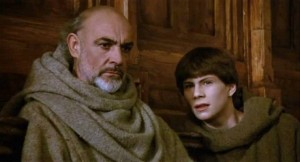
After multiple killings, several attempts to murder Brother William, and a slew of witchcraft and heresy accusations, the monastery is destroyed by fire. In an attempt to trap William and his novice, Adso of Melk, Venerable Jorge de Burgos knocked over a candle to put the room in darkness. Instead, the candle ignited a blaze which consumed the entire library and many of the monks.
William had discovered Jorge, the ancient librarian, had poisoned the pages of a book by Aristotle he deemed too dangerous to read. This poison killed any monk turning its pages. William deduces that the library is kept hidden because such advanced knowledge, coming from pagan philosophers, is difficult to reconcile with Christianity. 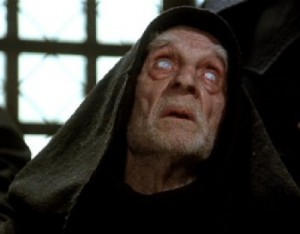
As they watched the library tower burn (and Venerable Jorge along with it) Brother William explained to his novice that unlike church teaching, the Devil is not merely a tempter of forbidden sensuality and knowledge: “They lied to you. The Devil is not the Prince of Matter; the Devil is the arrogance of the spirit; faith without smile, truth that is never seized by doubt.”
Can’t you see few people–right now–that fit that description?…The Glenn Becks of the world, Pastor John Hagee, ex-Bishop Joseph Martino of Scranton, Fr. C. John McCloskey of Opus Dei..We see their images in print, on blogs, on TV and sometimes–in the mirror.
There are defenses against Satan and his works. The usual antidote to pride is its opposite–humility–but one that springs from a willingness and effort to accommodate different kinds of people and stay together in bonds of prayer and friendship.
Adso observed: “We are fragile creatures, I said to myself; even among these learned and devout monks the Evil One spreads petty envies, forments subtle hostilities, but all these are as smoke then dispersed by the strong wind of faith, the moment all gather in the name of the Father, and Christ descends into their midst.”
